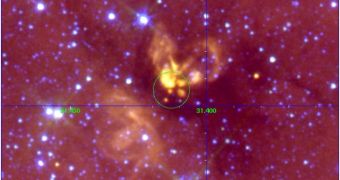An international team of astronomers has managed to detect the presence of a sugar molecule in the outer space. The chemical compound is known to be among the few primal building blocks that form life, and thus the discovery proves to be highly important in the search for Earth-like planets where life could appear and evolve. The finding was due to the Institut de Radio Astronomie Millimetrique (IRAM)'s radio telescope in Grenoble, France, which observed a region in space at different wavelengths and at high-angular resolution.
The region, whose name sounds like a good memory test (G31.41+0.31), is situated approximately 26,000 light years away from our planet. The research indicated that three glycolaldehyde (the sugar molecule) lines exist in the center of the area's core. This is the simplest structuring of monosaccharide sugars, which reacts with propenal to form the main constituent (called ribose) of the Ribonucleic acid (RNA), the primordial molecule that sparks life.
One of the authors of the research, Dr. Serena Viti from University College London, explained that "This is an important discovery as it is the first time glycolaldehyde, a basic sugar, has been detected towards a star-forming region where planets that could potentially harbor life may exist," as quoted by Scientific Blogging.
Professor Keith Mason, Chief Executive of the Science and Technology Facilities Council, backs her affirmation, "The discovery of an organic sugar molecule in a star forming region of space is very exciting and will provide incredibly useful information in our search for alien life. Research like this, combined with the vast array of other astronomical projects involving UK researchers, is continually expanding our knowledge of the Universe and keeping the UK at the forefront of astronomy".
Finding the molecule in such a remote location in the tough conditions at the center of the Milky Way – the sole place where it has been detected – may hold proof that this crucial life ingredient could be more commonly present in the galaxy than previously thought.

 14 DAY TRIAL //
14 DAY TRIAL //